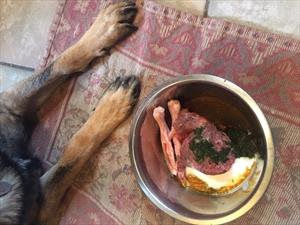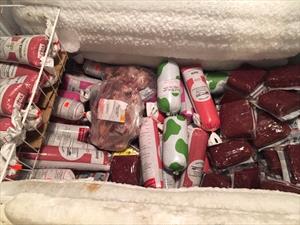You may have heard about raw food diets for dogs and cats.
Raw food dinner

Finny's raw diet meal on this day was ground meat (bone in quail), green juiced vegetable/herb mix, duck feet, white goat milk kefir, and yellow tumeric paste. Photo by Mary Buck.
Manufacturers of commercially prepared raw pet food for dogs and cats and the FDA seem to be getting on each other’s nerves these days. The reason behind this turf war is a sometimes terrible and sometimes innocuous bacterium called Salmonella. It’s the stuff found in a lot of vegetables, on reptiles, raw chicken, in petting zoos, and raw eggs, to name a few sources. The FDA has been recalling some commercially made raw pet food diets.
"Sam 'n Ella," as you may have heard it mispronounced, affects the GI tract, so people, dogs or cats who eat it may or may not have some resulting tummy issues, including diarrhea, a fever, and stomach cramping. Do people die from Salmonella? Yep. The CDC says there are “about 1.2 million illnesses, 23,000 hospitalizations, and 450 deaths [of people] in the United States every year.” And those are just the reported cases of food poisoning. Can dogs and cats die from it too? You bet.
So, have you heard about raw food diets for dogs and cats? It’s been a growing, albeit highly controversial, trend for about three decades or so.
Advocates of a raw diet say kibble is terrible for animals’ health, are biologically inappropriate as dogs and cats were never meant to eat cereal with some protein tossed in, and that their pets are healthier than they are on kibbled diets as some diseases or conditions such as allergies seem to disappear; plus, they get the added bonus of sparkly white teeth. Most veterinarians don’t approve of raw food diets, to put it mildly, but a handful give it to their own pets or recommend it for patients.
Opponents say the raw diet is swimming with bacteria that pose public health risks to pets and the humans who feed it to them (recall those 450 U.S. residents mentioned above who die every year as a result of Salmonella). They also assert that raw diets are not nutritionally balanced, unlike dry commercial diets that meet Association of American Feed Control Officials requirements, and that raw diets make pets and people sick because those pets who eat it shed the bacterium in their feces, thereby spreading the risk to people. That’s why therapy dogs are not usually allowed to eat raw diets.
Salmonella, like many other bacteria, can be spread by ingesting uncooked or undercooked meat and eggs, or by fecal-oral contamination (you touch poop and then touch your mouth, and you can take in some bacteria). Salmonella is the main reason you see warnings on menus about not eating undercooked meat or eggs.
The Centers for Disease Control and Protection states that food is the source for most cases of salmonellosis. Most persons infected with Salmonella develop diarrhea, fever, and abdominal cramps 12 to 72 hours after infection. The illness usually lasts 4 to 7 days, and most persons recover without treatment. However, in some persons, the diarrhea may be so severe that the patient needs to be hospitalized.”
There is no doggy CDC or World Health of Pets Organization, so dog and cat cases aren’t tracked, not even by the American Veterinary Medical Association. The AVMA does, however, discourage raw food diets. They say to eliminate pathogens by cooking food well (above 160oF in most cases), or by serving kibble or canned food.
The AVMA lists a variety of pathogenic organisms that can be found in raw meat, including Salmonella spp, Campylobacter spp, Clostridium spp, Escherichia coli, Listeria monocytogenes, and enterotoxigenic Staphylococcus aureus (just in case you were thinking that Salmonella was the only icky thing you had to worry about).
The FDA is crystal clear about why they think a raw food diet is bad for you and your pets.
If it’s so dangerous, why have some pet owners been using this diet for decades?
Mary Buck of Seattle is one of those people who began 30 years ago when her first German Shepherd Dog, Andy, was diagnosed with a progressive autoimmune disease called degenerative myelopathy. Her veterinarian said there wasn’t anything they could do for him, so Mary switched to a holistic vet who believed that food is medicine and that pets should eat the best food possible. The raw food diet movement was in its infancy then with the advent of Ian Billinghurst’s book about raw food diets. She was incredibly nervous about it at first, and like everyone else started with chicken body parts from the grocery store, and then ground turkey and turkey necks.
Her dog’s prognosis was 18 months, but he lived about 4.5 years before she lost him at 13.5. Coincidence? Maybe, maybe not. The only thing we know for sure is that we don’t know the scientific answer to Andy’s longevity.
These days, Mary has her 8th and 9th dog with the same holistic vet.
Before his raw diet, Andy would have skin infections, runny poop, bad breath, and smelled "funky." All of that went away on raw, she says. She has annual bloodwork done, but other that they don’t see the vet much because there doesn't seem to be a need, and if there is a need they go. Her working dogs have energy.
"My perception is that dogs are so much healthier," says Mary. "When your dog is sick, you feel helpless. The vet gives you pills. I never felt like I was active in their health care then, but when I feed raw I feel involved in their general health. I have some control. Pet food recalls are not on my radar, and that's so much more important now than it was when I was started."
Chest freezer of meat

This chest freezer is one of two full of bulk meat purchased at a raw food co-op for Mary Buck's dogs. Photo by Mary Buck
Rather than wait for a diagnosis, she asks her holistic vet what she can add to the diet to help prevent something like the hip dysplasia to which German Shepherd Dogs are prone.
She knows that there are pros and cons of any diet, including the one she's embraced. Mary believes her dogs' immune systems are better, and that they live longer, healthier lives than most dogs on kibble. Although Salmonella is everywhere, she thinks that her dogs are not at risk from it. She thinks because Salmonella is everywhere that the FDA is unfairly targeting raw food.
The cons are the added expense, equipment, and inconvenient amount of time it takes to prepare their food (she works full time and is a dog trainer on the side) as well as the elevated risk of food-borne illnesses like Salmonella. While commercially prepared raw foods are available, they're far more expensive than buying ingredients in bulk, and she currently has a German Shepherd dog and a Belgian Malinois. She has two chest freezers full of dog food and a Vita Mix in which she juices vegetables every six weeks and freezes them. She buys meat in bulk from a raw food co-op, where no antibiotics are used in the animals.
She's careful to take human precautions, too. She washes their bowls with hot soapy water; for meals including bones, she places the bowls on cotton rag rugs on which the dogs are trained to chew bones, and then she washes the rugs. She cleans her counters carefully with appropriate cleaners. Neither she nor her husband have ever been ill with any bacterium related to raw food.
So far, none of her raw-fed dogs have been diagnosed with or died from anything related to a raw diet.
But are 9 dogs doing well on a given diet an anecdotal success or a magic bullet?
Again, we don't know the scientific answer. Most raw feeders have the same beliefs, if not operating style, that Mary does. Raw feeders tend to have deep beliefs that this is the only way to go - some going to the point of zealotry - and that veterinarians are wrong, because they have seen their own handful of dogs do well. They have not had occupational exposure to hundreds of dogs coming in sick. Veterinarians look at the science. Will raw feeders and the majority of veterinarians ever meet in the middle? Will raw diets become the norm or fade from society? Who knows.
While there are no clinically proven benefits of a raw-food diet, the hazards and risks are well documented. Pet owners considering this diet need to understand that intestines can be perforated or obstructed by bones, and that chewing raw bones can cause dental fractures. Owners can make themselves sick if they are not careful, and Salmonella is a far cry from a garden-variety stomach bug.
I asked a nameless veterinary co-worker (Christy!) what she thought about raw food diets and she said, not mincing words, “%$% no! Most people can’t handle their own nutrition. You can't tell me that dogs magically don't spread their raw food all over the kitchen.” Let’s face it, most people do a poor job at their own nutrition (says the woman who just had a vegetarian Indian buffet and too mant peanut M&Ms for lunch; the peanuts are excellent protein, you know, especially when added to lentils).
What we do know is that if you are going to fly in the face of conventional veterinary norms, you’d better know what you’re doing and what the risks are. Ignorance is not bliss, and in this case it can be deadly dangerous, so do your research. Talk to a veterinary nutritionist or holistic veterinarian. Feeding raw is not for the faint of heart or light of wallet – or wonky immune systems – and it’s a serious commitment that goes far beyond going to the grocery store to buy chicken parts and veggies to chop. You will also likely be in permanent disagreement with your regular veterinarian, unless you find one with an alternative/complementary bent.
Pet owners need to understand that that scientific proof – well-run, double-blinded, placebo-controlled research - is how veterinarians know how to treat animals. Their goal is to heal your animal, not make them worse. Clear communication from each side will go a long way towards healing the divide between raw food feeders, veterinarians, and the FDA.
Well, maybe not the FDA...
4 Comments
Yumiko
February 25, 2022
David Fernandez, DVM
May 1, 2019
NF
April 22, 2019
Lisa Marie McKay
April 22, 2019